Unlocking Insights: Integrating Google Ads and Google Analytics APIs for Custom Data Retrieval and Reporting
In today's data-driven marketing landscape, understanding the intricate details of your campaigns and user behaviour is key to maximising return on investment (ROI) and refining strategies. Integrating Google Ads and Google Analytics APIs can provide a comprehensive view of how your ads influence user interactions and conversions. This integration enables marketers to retrieve, process, and report custom data, making informed decisions more accessible. Here’s a closer look at how this powerful combination works and why it’s indispensable.

The Power of Integration
Integrating Google Ads and Google Analytics APIs brings together the strengths of both platforms. Google Ads API provides deep insights into ad performance, while Google Analytics API offers a detailed look at user behaviour on your website. When combined, they offer a unified view that is greater than the sum of its parts.
Google Ads API
The Google Ads API is a robust tool that allows marketers to programmatically manage their campaigns, retrieve performance data, and automate reporting processes. Key functionalities include:
Campaign Management
Easily create, update, and manage Google Ads campaigns. This includes adjusting budgets, setting targeting criteria, and updating ad creatives based on performance insights.
Performance Metrics
Access essential performance data such as impressions, clicks, conversions, and costs. These metrics are crucial for evaluating the effectiveness of your campaigns and
Automated Reporting
Generate custom reports that track your key performance indicators (KPIs) over time. This automation saves time and ensures you always have up-to-date data at your fingertips.
Google Analytics API
Google Analytics API provides comprehensive data about user interactions on your website. This includes:
User Behaviour
Gain insights into how users navigate your site, including page views, session duration, bounce rates, and more. This data helps you understand user engagement and identify potential issues in the user journey.
Conversion Tracking
Monitor specific goals such as form submissions, purchases, and other valuable actions. Understanding these conversions is critical for assessing the success of your marketing efforts.
Custom Reporting
Create tailored reports that focus on the metrics and dimensions most relevant to your business. Custom reports allow for a more detailed analysis that generic reports might not provide.
Seamless Data Retrieval and Processing
By integrating these APIs, you can create a seamless data flow between Google Ads and Google Analytics, enabling detailed analysis and reporting.
Data Retrieval
Secure Access
Use OAuth 2.0 to obtain access tokens, ensuring secure and authenticated data requests.
Targeted Queries
Retrieve specific data sets tailored to your needs. For example, query Google Ads for click and conversion data by campaign and pull user engagement metrics from Google Analytics for those same campaigns.
Data Processing
Data Merging
Combine datasets from Google Ads and Google Analytics to create a holistic view of your marketing performance. For instance, link ad click data with site engagement metrics to see the complete user journey.
Data Cleaning:
Ensure the accuracy and consistency of your data by cleaning and normalising it. This step is vital for reliable analysis and reporting.
Custom Reporting for Actionable Insights
Custom reporting transforms raw data into actionable insights, empowering you to make informed decisions.
Interactive Dashboards
Use tools like Google Data Studio or Tableau to create interactive dashboards. These visualisations can display combined data from both APIs, offering a clear and comprehensive view of your marketing performance.
Automated Reports
Set up automated reporting schedules to generate and distribute reports regularly. This ensures stakeholders are always informed and can respond quickly to any changes in campaign performance.
Real-World Impact
Enhanced Insights
Gain a deeper understanding of how your ads drive user behaviour and conversions. This holistic view helps you fine-tune your strategies and improve overall performance.
Optimised Spending
Identify the most effective campaigns and keywords, allowing you to allocate your budget more efficiently and maximise ROI.
Time Savings
Automate data retrieval and reporting, freeing up your team to focus on strategy and creative work rather than manual data processing.
Customization
Tailor data and reports to your specific needs, ensuring you get the insights most relevant to your business goals.
Active Events
Best Tips to Create a Job-Ready Data Science Portfolio
Date: Feburary 26, 2025 | 7:00 PM(IST)
7:00 PM(IST) - 8:10 PM(IST)
2811 people have registered
Unlocking Lucrative Earnings: Mastering Software Engineering Salaries
Date: Feburary 25, 2025 | 7:00 PM(IST)
7:00 PM(IST) - 8:10 PM(IST)
2811 people have registered
Bootcamps
Full Stack Software Development Bootcamp
- Duration:4 Months
- Start Date:Feb 9, 2025
Data Science Bootcamp
- Duration:4 Months
- Start Date:Feb 9, 2025
